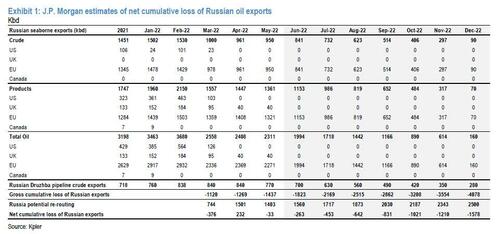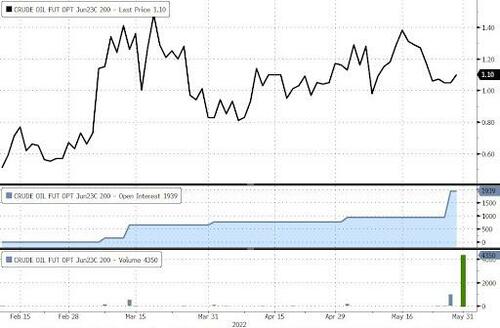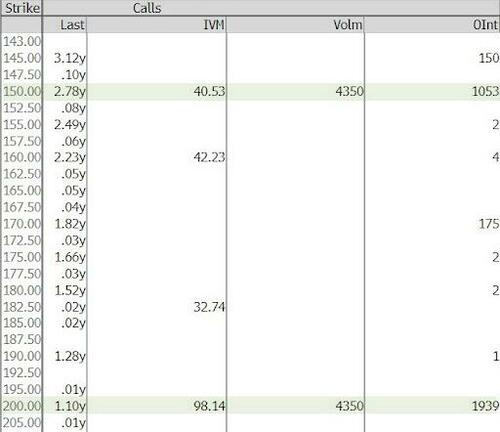JPM Sees Oil Rising Up To $136 This Month Depending On What China Does, As Trader Bets Millions On Crude Explosion To $200
When it comes to forecasts for the price of oil, two distinct camps have emerged on Wall Street. In one, we have Citi, whose chief commodity strategist, Ed Morse, has been pounding the table calling for lower oil and most recently telling BBG TV that the fair value of Brent futures is in the $70 range even though the international benchmark is trading around $120 a barrel. Needless to say, Morse has been dead wrong so far, and anyone who listened to him has suffered catastrophic losses on the short side, although maybe he will be correct in the end: his forecast is predicated on unprecedented demand destruction, with Citi cutting its demand estimate for products to 2.2 million barrels a day, down from 3.6 million barrels at the start of the year. Alas, despite record prices for every energy product, there has so far been zero demand destruction as even Bloomberg’s resident in-house commodity expert Javier Blas pointed out earlier today.
OIL MARKET: After a short-lived correction in late May, refining margins are rocketing again, with the WTI 3-2-1 crack margin surging above $52.5 a barrel. The refined products markets continues to lead (where’s the demand destruction?), encouraging higher refinery runs #OOTT
— Javier Blas (@JavierBlas) June 1, 2022
In the other corner, we have pretty much everyone else, including such commodity bulls as Goldman and JPMorgan, the latter of which just published a note (available to ZH pro subs in the usual place), in which the bank’s oil analyst, Natasha Kaneva, writes that while the recent decision by the EU to ban Russian oil as part of its sixth package of sanctions, sent the price of oil to the highest level in two months, “where prices go from here will depend on whether Russia can divert its oil to China.”
First, some background.
According to JPM, Russia has so far been able to find plenty of willing buyers for its deeply discounted crude oil, and has so far not only been able to fully offset the 0.7 mbd crude export loss to its traditional customers in the US and Europe, but has managed to sell an additional 1.4 mbd to Asia buyers! Accordingly, Russian oil production has stabilized, and after averaging about 1 mbd lower in April, it has increased 200-300 kbd MoM in May, with more volumes expected to be restored next month.
While India has been snapping up distressed crude cargoes from Russia to feed its giant refining complexes, the increase to China, the world’s biggest importer, has been more modest—just 165 kbd—and has come chiefly from Eastern Russia ports rather than Russia’s Baltic and Black Sea ports which traditionally fed into Europe. India’s daily shipments from Russia have surged from zero in the weeks prior to the invasion to 953 kbd in April and have come from Western Russia ports, replacing some European demand.
What does that mean for the price of oil? Well, according to JPM, given time, and given large discounts to encourage exports to Asia, Russia will be able to redirect most of its exports and peg maximum impact on Russian production at 1.5 mbd (Exhibit 1). As such, the bank maintains its Brent price forecast of $114/bbl for 2Q22, with a peak month average of $122/bbl in June and averaging $104/bbl for 2022. For its view to materialize, the largest US commercial bank assumes India’s purchases of Russian crude will stabilize at a pace of around 500 kbd, and that, as Chinese demand recovers from nearly two months of COVID lockdowns, China would add another 1 mbd to its crude imports of Russian origin.
However, more demand is coming from China which is reportedly looking to increase its purchases to replenish its strategic crude stockpiles and talks are ongoing at government level. JPMorgan estimates that China can easily add another 1 mbd of Russian crude to its diet, although so far we have only seen marginal China purchases of crude from Western Russia ports. And while shipping oil under these latest sanctions will be more difficult, Russia still has the ability to get its exports to their destinations.
As such, JPM estimates Russia will be able to find shipping capacity to transport about 3 mbd of its crude oil to Asia and that sovereign insurance will be provided by the receiving countries. Both Indian and Chinese governments had previously approved coverage from state-run insurers setting a precedent that it could be done again in the future should the need arise and should the price be advantageous.
But were China to disappoint, and not ramp up purchases of Russian crude, JPM sees Brent prices averaging $122/bbl in 2Q22, peaking at monthly average of $136/bbl in June, followed up by $118/bbl in 3Q22, and $105/bbl in 4Q22.
The result – according to JPM who echoes what we said 3 months ago…
Russian oil bidless, non-Russian oil offerless https://t.co/2n6o258AGE
— zerohedge (@zerohedge) March 3, 2022
… will be “a bifurcated market: on one side Europe and the US in need of more domestic and OPEC supply to fill the gap and on the other side Russia, selling oil at large discounts to Asia.”
Russian Urals crude is already trading at a $30/bbl discount to Brent. While the OPEC reference price for Venezuela’s Merey crude, also under sanctions, is about $30/bbl lower than Brent, the actual purchase price for sanctioned barrels could be much lower—China’s $30/bbl tax on “diluted bitumen” enacted last year makes an even steeper discount on Venezuelan crude likely. Brent-$30 for Urals may be as much as Russia could reasonably expect to receive for its crude for the foreseeable future. Overall, Russia’s pricing power in the global oil market would be virtually eliminated.
And confirming that JPM’s “worst case” scenario is in the cards, on Tuesday an unknown trader wagered almost $8 million that WTI will soar. Specifically, the June 2023 WTI $150 and $200 calls traded about 4.35k times in a call spread strategy in multiple block trades.
The $150 calls traded at $2.76 and the $200 calls at $0.98, costing approx $7.7 million in premium.
According to Bloomberg, the trade is hedged with futures, and has a delta of 10. The largest trade in terms of aggregate size was a WTI butterfly call spread trading 2.4k times for August $140, $150, and $160 calls.
Tyler Durden
Wed, 06/01/2022 – 15:08
via ZeroHedge News https://ift.tt/rNF5cZU Tyler Durden


